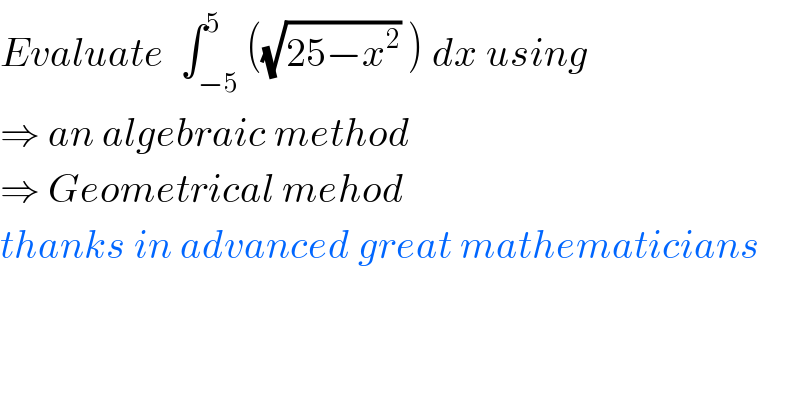
Question and Answers Forum
Question Number 72337 by Rio Michael last updated on 27/Oct/19

Commented by mathmax by abdo last updated on 27/Oct/19
![algebric method let A=∫_(−5) ^5 (√(25−x^2 ))dx ⇒A=2∫_0 ^5 (√(25−x^2 ))dx (even function) ⇒A =_(x=5sint) 2∫_0 ^(π/2) (√(25−25sin^2 t))5cost dt =50 ∫_0 ^(π/2) cos^2 t dt =25 ∫_0 ^(π/2) (1+cos(2t))dt =((25π)/2) +((25)/2)[sin(2t)]_0 ^(π/2) =((25π)/2)](Q72349.png)
Answered by MJS last updated on 27/Oct/19
![geometrical method y=(√(25−x^2 )) is the upper semicircle with center ((0),(0) ) and radius 5; integral = area ⇒ ∫_(−5) ^5 (√(25−x^2 ))dx=((5^2 π)/2)=((25)/2)π algebraic method ∫(√(25−x^2 ))dx= [t=arcsin (x/5) → dx=5cos t dt] =25∫cos^2 t dt=((25)/2)∫1+cos 2t dt= =((25)/2)x+((25)/4)sin 2t =((25)/2)arcsin (x/5) +(1/2)x(√(25−x^2 )) +C now use borders](Q72341.png)
Commented by Rio Michael last updated on 27/Oct/19

| ||
Question and Answers Forum | ||
Question Number 72337 by Rio Michael last updated on 27/Oct/19 | ||
 | ||
Commented by mathmax by abdo last updated on 27/Oct/19 | ||
![algebric method let A=∫_(−5) ^5 (√(25−x^2 ))dx ⇒A=2∫_0 ^5 (√(25−x^2 ))dx (even function) ⇒A =_(x=5sint) 2∫_0 ^(π/2) (√(25−25sin^2 t))5cost dt =50 ∫_0 ^(π/2) cos^2 t dt =25 ∫_0 ^(π/2) (1+cos(2t))dt =((25π)/2) +((25)/2)[sin(2t)]_0 ^(π/2) =((25π)/2)](Q72349.png) | ||
Answered by MJS last updated on 27/Oct/19 | ||
![geometrical method y=(√(25−x^2 )) is the upper semicircle with center ((0),(0) ) and radius 5; integral = area ⇒ ∫_(−5) ^5 (√(25−x^2 ))dx=((5^2 π)/2)=((25)/2)π algebraic method ∫(√(25−x^2 ))dx= [t=arcsin (x/5) → dx=5cos t dt] =25∫cos^2 t dt=((25)/2)∫1+cos 2t dt= =((25)/2)x+((25)/4)sin 2t =((25)/2)arcsin (x/5) +(1/2)x(√(25−x^2 )) +C now use borders](Q72341.png) | ||
| ||
Commented by Rio Michael last updated on 27/Oct/19 | ||
 | ||